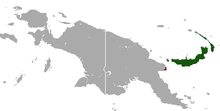Bismarck masked flying fox
| Bismarck masked flying fox | |
|---|---|

| |
| Scientific classification | |
| Domain: | Eukaryota |
| Kingdom: | Animalia |
| Phylum: | Chordata |
| Class: | Mammalia |
| Order: | Chiroptera |
| Family: | Pteropodidae |
| Genus: | Pteropus |
| Species: | P. capistratus
|
| Binomial name | |
| Pteropus capistratus Peters, 1867
| |

| |
| Bismarck masked flying fox range (green — native, brown — vagrant) | |
| Synonyms | |
| |
The Bismarck masked flying fox (Pteropus capistratus) is a species of flying fox in the family Pteropodidae found in Papua New Guinea and named after the Bismarck Archipelago. It was once considered a subspecies of Pteropus temminckii before being reassessed in 2001. This species has two subspecies, P. c. capistratus and P. c. ennisae.[2] The IUCN classified it as Near Threatened in 2009, noting that the rate of decline is almost high enough to reclassify the species as Vulnerable.[3]
Taxonomy
The Bismarck masked flying fox was described as a new species in 1867 by German naturalist Wilhelm Peters.[4] Prior to 1995, the Bismarck masked flying fox was largely considered a subspecies of the Temminck's flying fox (Pteropus temminckii).[5]
Description
Its forearm length is 109–118 mm (4.3–4.6 in).[6]
Biology and ecology
It is one of the rare species of mammals in which the males can lactate.[7] It is generally solitary, though males and females may roost together in pairs.[8]: 6
Range and habitat
The Bismarck masked flying fox is endemic to Papua New Guinea where it has been documented at a range of elevations from 0–1,200 m (0–3,937 ft) above sea level.[3]
Conservation
As of 2010, it is evaluated as a near-threatened species by the IUCN. It meets the criteria for this designation because of widespread habitat destruction across its range. It is likely experiencing "significant" population decline, though not higher than 30% over ten years, which would qualify it as a vulnerable species.[3]
References
- ^ "Pteropus capistratus ". IUCN Red List of Threatened Species.
- ^ D.E. Wilson & D.M. Reeder, 2005: Mammal Species of the World: A Taxonomic and Geographic Reference. Third Edition. The Johns Hopkins University Press, Baltimore
- ^ a b c Hamilton, S.; Bonaccorso, F.; Helgen, K.; Allison, A. (2010). "Pteropus capistratus". IUCN Red List of Threatened Species. 2010: e.T136373A4282456. doi:10.2305/IUCN.UK.2010-2.RLTS.T136373A4282456.en. Retrieved 19 November 2021.
- ^ Peters, W. (1867). "Mittheilung über die Pelzrobbe von den Inseln St. Paul und Amsterdam und über die von S.M.S. Gazelle mitgebrachten Flederthiere" [Communication about the fur seals from the islands of St. Paul and Amsterdam and those of S.M.S. Gazelle brought along bats]. Monatsberichte der Königlichen Preussische Akademie des Wissenschaften zu Berlin (in German): 316–317.
- ^ "Pteropus capistratus". ITIS. Retrieved 17 August 2019.
- ^ Flannery, T. F. (1995). Mammals of the south-west Pacific & Moluccan Islands. Cornell University Press. p. 184. ISBN 978-0801431500.
- ^ Bats: A World of Science and Mystery (Hardcover) by M. Brock Fenton, Nancy B. Simmons, p. 168.
- ^ Pierson, E. D.; Rainey, W. E. (1992). "The biology of flying foxes of the genus Pteropus: a review". Biological Report. 90 (23).

